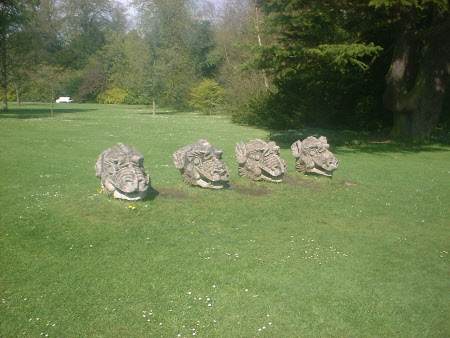Dragon's Head (Bishopsgate, London)
Christopher Horsnaile the elder (London c.1658 - London 1742)
Category
Art / Sculpture
Date
1733 (payment recorded) - 1734
Materials
Stone
Measurements
711 x 1041 mm (28 x 41 in)
Place of origin
London
Order this imageCollection
Wallington, Northumberland
NT 584972
Caption
Four striking dragons’ heads lie on the lawn at Wallington in Northumberland. These magnificent carved stone sculptures are believed to be part of a group that once adorned Bishopsgate, proudly guarding an entrance to the City of London. The historical gate was rebuilt in the 1730s, but just 30 years later it had become too small for London’s growing traffic. The dragons were removed and the gate was demolished in the 1760s, along with other City of London gates including Ludgate, Cripplegate and Aldgate. The dragons were purchased as architectural salvage by the owner of the Wallington estate, Sir Walter Calverley Blackett (1707–77), 2nd Baronet. Along with other pieces of sculpture, he allegedly used the dragons as ballast on his coal barge up the coast to Newcastle. It is thought that he displayed the impressive heads for a time at the Gothic folly Rothley Castle, built in around 1755 on the hillside above Wallington. Since 1928 they have watched over visitors from their current position on the lawn.
Summary
Portland stone, Dragon's Head (Bishopsgate, London) by Christopher Horsnaile the elder (London c.1658 - London 1742), 1733/4. One of four dragons' heads from Bishopsgate, one of the City of London's Gates, demolished in 1760.
Provenance
On Bishopsgate, London 1733/4 until the demolition of the City of London's Gates (Ludgate, Cripplegate, Aldgate and Bisopsgate) in 1760 and (Aldersagte and Moorgate in 1761); according to family tradition, the sculptures were probably brought to the Tyne as ballast in one of Sir Walter Blackett's ships. It has been suggested that when he saw them he had them taken to his sham-castle or folly at Rothley, Northumberland (John Hodgson 'History of Northumberland', 1827, Part II, vol. 1,page 305); at Rothley Crags until 1879;[...]; given with the property to the National Trust in 1941 by Sir Charles Philips Trevelyan, 3rd Bt (1870 – 1958)
Makers and roles
Christopher Horsnaile the elder (London c.1658 - London 1742), sculptor
References
Adshead 2007 David Adshead, 'Dragon's on the Lawn The Afterlife of London's City Gates at Wallington', Apollo [National Trust Historic Houses & Collections Annual], 2007, pp.50-6








